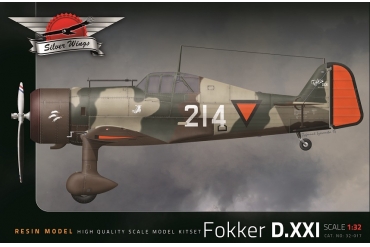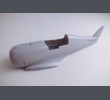Fokker D.XXI
-
 Box
Box
-
 Fokker D.XXI “214" - Dutch Air Force - 1-II-1 LvR (1e JaVa), De Kooy, Autumn 1938
Fokker D.XXI “214" - Dutch Air Force - 1-II-1 LvR (1e JaVa), De Kooy, Autumn 1938
-
 Fokker D.XXI “212" – Dutch Air Force - 1–V-2 LvR (1e JaVa), Ypenburg, Summer 1940
Fokker D.XXI “212" – Dutch Air Force - 1–V-2 LvR (1e JaVa), Ypenburg, Summer 1940
-
 Fokker D.XXI “15" - Luftwaffe - ex 1e JaVa "Witte Muizen", Summer 1940
Fokker D.XXI “15" - Luftwaffe - ex 1e JaVa "Witte Muizen", Summer 1940
- Cat. No.:
- 32-017
- Material:
- resin
- Scale:
- 1:32
- Period:
- 1936-1948
- Marking options:
- 3 (Dutch Air Force, Luftwaffe)
- Number of parts:
- 160 x resin, 40 pe, film
- Length & wingspan:
- 256 x 343 (mm)
- Additional features:
- main elements iron reinforced
- Price:
-
History
Designed by Anthony Fokker in 1935, the Fokker D.XXI first flew on March 27th, 1936. The system was originally intended to fill the ranks of the Netherlands East Indies Army Air Service but the arrival of World War 2 eventually pressed it into service with Finland, Denmark and Netherlands air force units against Germany. Operationally, the D.XXI proved a reliable airframe with solid performance specifications, good maneuverability and was relatively inexpensive to produce. At the time it proved quite a revolutionary step forwards for the Dutch, with many of its current aircraft still resembling the biplanes of a forgotten era of military aviation. 200 planes were produced in Netherlands with additional license-production occurring in both Denmark and Finland.
Armament initially consisted of 4 x 7.92mm FN Browning M36 machine guns, two mounted in the upper engine cowling synchronized to fire through the spinning propeller blades with an additional two in the wings (one to a wing). Finnish-produced aircraft had their cowling machine guns relocated to the wings, paired with the existing two.
Deployment of the D.XXI began as early as 1936 with limited quantities used for the first time in anger by the Spanish Republic in the Spanish Civil War. By May of 1940, D.XXIs were quantitatively available to the Dutch Air Force in time to combat the German invasion. With only 28 Fokker D.XXIs in service to them, Dutch pilots of the Dutch Army Aviation Group valiantly faced a better foe fielding the impressive Messerschmitt BF 109 inline-engined, single-seat monoplane fighters. D.XXI's held their own against the well-trained and confident invaders during a barely-week-long stretch, though the Netherlands eventually capitulated to the Nazis after this five-day span - receiving little help from the Allies. For their short time in service with the defending Dutch pilots, May 10th represented the aircraft's finest day in combat scoring 13 air kills - though it should be noted that this occurred against Junkers Ju 52 transport aircraft. In all, the Netherlands fielded a total of 36 D.XXIs.
License production D.XXIs in Finland ran from 1939 until 1944. These systems were differentiated by the aforementioned machine gun allocation as well as internal provisions to take on either the Bristol Pegasus or Pratt & Whitney Twin Wasp Junior radial engines of 825 horsepower. Finnish D.XXI's fared surprisingly well against the early-form Soviet fighters in their Winter War - the Soviet Union's invasion of Finland - making up seven Finnish Air Force squadrons. Over the subsequent months, the D.XXI quickly became outclassed by the better-armed and better-performing Soviet fighters. Despite this, several Finnish pilots were able to achieve "ace" status flying these machines. In all, Finland produced 90 such D.XXIs and received a noted delivery of at least 7 more systems.
As the other license-producer of the aircraft, Denmark D.XXIs operated against the German Luftwaffe in March of 1940. Denmark produced 15 new-build systems and received at least 7 more D.XXIs.
The Fokker D.XXI also operated under German Luftwaffe markings as captured systems reintegrated into service . The number of aircraft in use by the Luftwaffe was unknown.
Technical data:
Length: 8,2 m
Width: 11,00 m
Height: 2,95 m
Empty weight: 1,450 kg
Powerplant: 1x Bristol Mercury VIII 9-cylinder radial piston engine delivering 830 hp
Maximum speed: 460 km/h
Maximum range: 950 km
Service ceiling: 11,000 m
Armament: 4 × 7.7 mm (0.303 in) Vickers machine guns
































